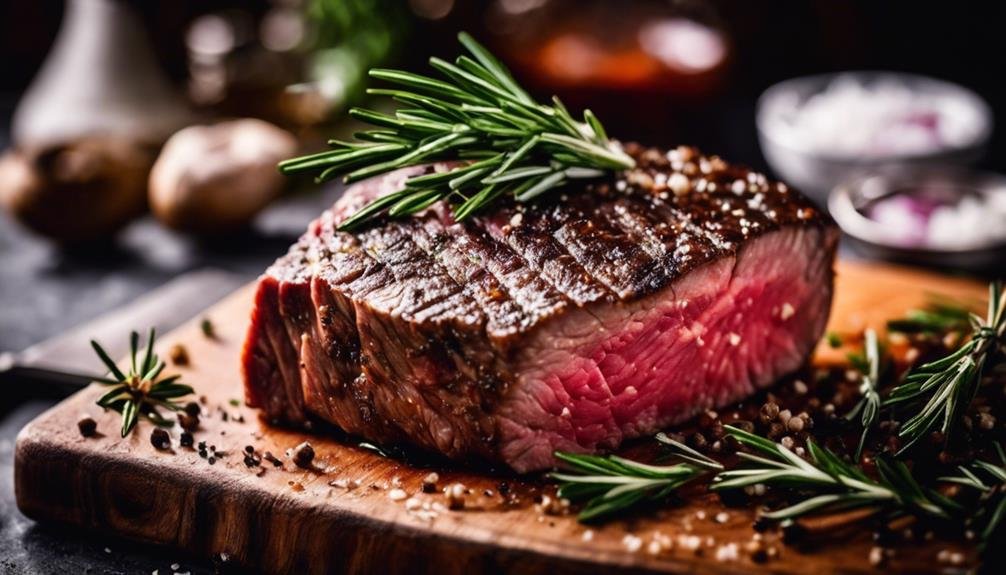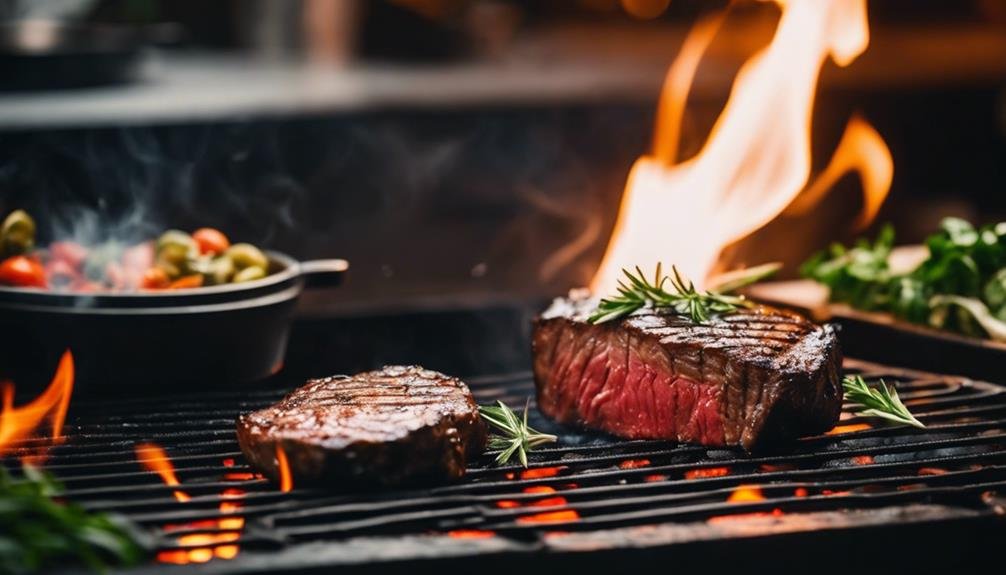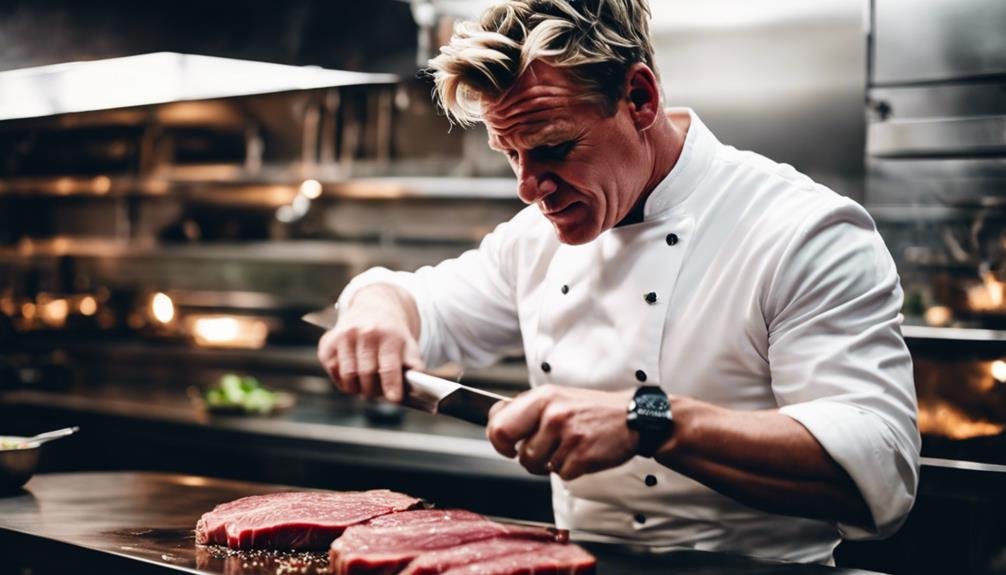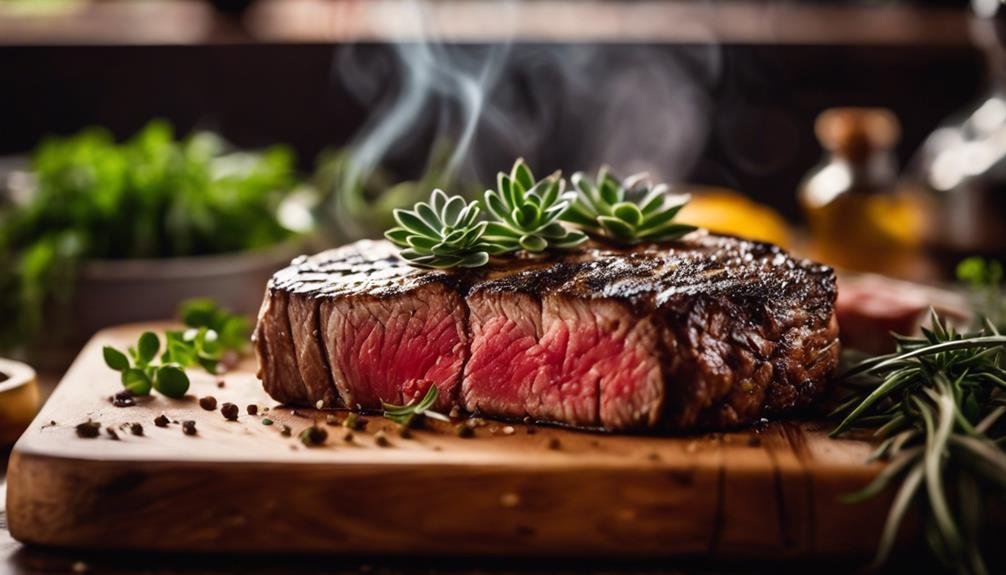You stand at the threshold with marbled steak in hand, contemplating the shift from raw to remarkable. The deep red hue whispers promises of flavors untold, and the rim of fat proves juicy bites ahead. You recall Gordon Ramsay steak wisdom: a steak, like a moment, is fleeting, and its perfection hinges on the dance of heat and timing.
Seasoning is not just about salt and pepper but awakening the meat’s soul. As your skillet sears, the steak, butter, garlic, and herbs join, each baste a brushstroke on a taste canvas. Resting, though a pause, is the secret to tenderness. In this contemplative dance, it’s here that simplicity meets mastery, and you inch closer to unraveling Ramsey’s culinary alchemy.
Selecting Your Steak
To ensure a succulent and flavorful meal, select a steak with plenty of marbling and a minimum thickness of one inch. Marbling, the fat weaving through the beef, melts during cooking, enhancing flavor and tenderness. Opt for cuts that exhibit a deep red hue, signaling freshness and quality. A rim of fat around the steak seals in moisture, elevating the dish to a culinary delight.
In this quest, instincts guide toward choice cuts. The steak’s texture, color, and satisfaction promise are key. This selection process nourishes not only the body but also the soul.
For example, choosing a Ribeye from Omaha Steaks guarantees a marbled, thick cut ideal for a juicy steak. Local butchers, like The Meat Hook in Brooklyn, offer expertly selected, high-quality beef, promising an exceptional dining experience. When shopping, remember that beef is a culinary canvas, offering endless possibilities for flavor and enjoyment.
A fascinating fact: The term ‘steak’ originated from the Old Norse word ‘steik,’ meaning meat on a stick.
Preparing the Meat

To craft a culinary masterpiece from a prime cut of beef, the preparation is crucial. Seasoning acts as an enhancement, salt and pepper elevate the beef’s natural flavors. Letting the beef reach ambient temperature showcases patience, ensuring uniform cooking. High heat transforms the beef’s surface into a flavorful crust, a testament to the art of searing. Basting the beef with Kerrygold butter, minced Gilroy garlic, and fresh Rosemary from your local farmer’s market introduces a rich complexity. Resting the beef post-cooking is essential for flavor infusion, allowing a moment for the masterpiece to reach its zenith.
The process mirrors an artist preparing their canvas, where every stroke and choice of color is deliberate. In this culinary art, ingredients from brands like Kerrygold and herbs from local markets like the Farmer’s Market in Union Square, New York, play significant roles. This preparation isn’t just about cooking but respecting the culinary journey.
A random fact: The concept of letting meat rest to enhance flavor and juiciness was popularized in the 20th century, showing how culinary practices evolve with time.
Mastering the Heat

To master the perfect steak, one must control the heat skillfully. This skill is the key to achieving the desired level of doneness, where every degree is critical. Think of your cooking surface, whether a Weber grill or a Le Creuset pan, as the stage for this culinary performance. Achieving the perfect sear is crucial, not only for the visual appeal of the grill marks but for locking in the meat’s natural juices, resulting in a flavor explosion.
Controlling temperature is like playing an instrument in a gourmet orchestra. For a rare steak, aim for an internal heat of 125°F, ensuring the meat remains lush and red. A medium steak, with its warm pink center, requires a target temperature of 135°F. And for those who favor a well-done piece, reaching a solid, fully cooked state at 160°F or above showcases both patience and mastery over the flame.
Gordon Ramsay, a maestro in the culinary world, advises against cutting into the steak to check its readiness. Instead, he recommends allowing it to rest, ensuring the flavors meld and intensify. This practice isn’t just about patience; it’s about elevating the eating experience to its highest level.
Local eateries, like The Butcher’s Block, often source their meat from renowned suppliers such as Creekstone Farms, ensuring that the quality of the steak matches the effort put into cooking it.
A random fact to chew on: The concept of resting meat after cooking it was popularized in the early 20th century, as chefs found that it made the meat more tender and flavorful.
Mastering the heat is thus a journey of precision, a celebration of flavors, and a tribute to the culinary arts.
The Touch Test Technique

The touch test technique offers a reliable method for gauging steak doneness by simply pressing it to feel its firmness. Imagine, you’re standing there, in your kitchen, freedom at your fingertips as you cook not by the clock, but by touch. This sensory evaluation isn’t just about poking your steak; it’s about connecting with your food, understanding its transformation from rare, with its soft, yielding texture, to well-done, where it stands firm under your press.
Rare, medium, or well-done, the choice is yours, and the touch test empowers you to achieve these doneness levels without hesitating. It’s a dance of heat, time, and touch, where you’re the lead, guiding your steak to its perfect state. You’re not just cooking; you’re setting off on a culinary adventure, where each steak becomes a sign of your skill and intuition.
Mastering this technique changes the game. You’re no longer tied to timers or bound by schedules. Each press, each judgment of firmness, brings you closer to that ideal plate of food. It’s about trusting your senses, embracing the fluidity of cooking, and celebrating the joy of achieving perfection on your own terms.
The touch test technique directly answers how to determine the doneness of a steak through tactile feedback. A chef’s gentle press on the steak’s surface gauges its readiness, a skill honed over time.
In the culinary world, a steak transforms under heat, moving from a tender, rare state to a resilient, well-done condition. This metamorphosis is guided by the chef’s intuition and touch, a dance between the cook and the ingredient.
By mastering the touch test, a chef gains freedom from mechanical timekeeping, relying instead on a sensory connection with the food. This skill transcends traditional methods, offering a direct path to culinary excellence.
Notably, renowned restaurants and chefs, such as Gordon Ramsay’s Steak or the local butchery, The Meat Hook, endorse and practice this technique, underscoring its credibility and utility in achieving the perfect steak.
A random fact: the sense of touch is also known as haptic perception, a critical skill in culinary arts for assessing the texture and doneness of meats.
Resting for Perfection

Resting your cooked cut of beef ensures a more succulent, flavorful bite. This practice, supported by culinary experts like Gordon Ramsay, is essential for achieving steak excellence. Here’s why:
- Juice redistribution in the beef cut enhances tenderness and taste consistency.
- A brief repose, lasting between five to ten minutes, prevents moisture loss, combating the feared dryness.
- Post-cooking, the beef’s core temperature gently increases, perfecting its readiness in a silent heat continuation.
- Premature slicing results in the escape of savory juices, diminishing the gastronomic delight.
- Ramsay, a culinary master, underscores this pause’s role in augmenting taste and texture.
This interlude not only enhances flavor but also embodies a lesson in patience, elevating the dining experience beyond the mundane. Local steakhouses, such as ‘The Charred Rib’ in New York, adhere to this practice, showcasing its value in the culinary community.
A random fact: The world’s most expensive steak, A5 Kobe beef, also benefits significantly from resting, allowing its rich marbling to fully express its flavor profile.
Frequently Asked Questions
How Do You Cook a Gordon Ramsay Well-Done Steak?
To cook a Gordon Ramsay well-done steak, first, ensure your steak is at room temperature. Heat a pan over medium-high, season your steak with salt and pepper. Sear each side for about 3-4 minutes, then lower the heat and continue cooking to reach an internal temperature of 160°F. Let it rest before serving.
How Do You Cook a Steak From Rare to Well Done?
To cook a steak to your preferred doneness, start with a high-quality, aged steak for enhanced flavor. Season or marinate it to your liking. For rare, sear each side on high heat for about 2-3 minutes. For medium, cook each side for 4-5 minutes. For well-done, extend the cooking time to 6-7 minutes per side on a lower heat to ensure it cooks through without burning. Always let it rest before serving to retain juices.
How to Make a Good Well-Done Steak?
To make a good well-done steak, first choose a high-quality cut. Marinate it to enhance flavor, then cook it slowly on a lower heat to reach an internal temperature of 160°F without drying it out. Resting it afterward allows juices to redistribute, ensuring a juicy, well-done steak.
How Do You Cook a Steak Well Done but Not Chewy?
To ensure a steak is well done without being chewy, focus on proper tenderizing and slow cooking. Start by marinating or using a tenderizer to break down fibers, then sear on high heat quickly before switching to a low, gentle heat to finish cooking. Resting it afterwards helps retain juices, ensuring the steak remains moist and flavorful despite the thorough cooking.




































